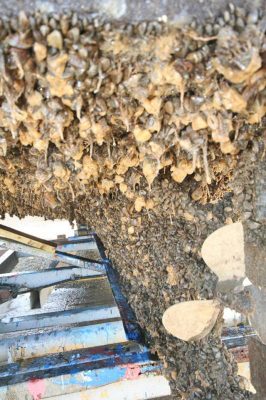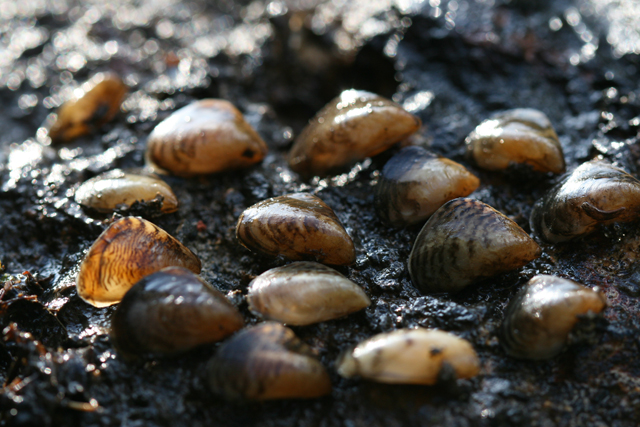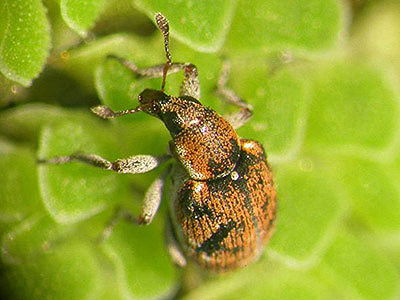First EU list of invasive alien species adopted
The European Commission adopted the first EU list of invasive alien species this month, requiring dedicated action across the Union.
Through the publication of Implementing Regulation 2016/1141, the EU Invasive Alien Species Regulation 1143/2014 will now apply to an initial list of 37 species (23 animals and 14 plants).
The outcome of the EU Referendum does not immediately impact the implementation of these regulations. Until the UK formally leaves the EU, we still have a legal obligation to comply with EU law and the invasive alien species regulations remain in force.

Zebra Mussel Hull Fouling. Credit: Jones Boatyard St Ives Cambs
What’s the risk?
Invasive non-native species can harm native habitats, block waterways, damage boating equipment and affect water treatment systems.
The aim of the EU Invasive Alien Species Regulation is to prevent or manage the introduction, or spread, of invasive non-native species across the European Union.
The UK is now required to put in place restrictions on commercial keeping, importing, selling, and the intentional breeding or release of these plants and animals.
Special provisions are included to deal with the specific needs of pet owners, traders, breeders and other stakeholders.
What animals and plants are affected by the Regulation?
There are 23 animals and 14 plants on the list of Union concern. These are:
Plants
- American skunk cabbage Lysichiton americanus
- Asiatic tearthumb Persicaria perfoliata (Polygonum perfoliatum)
- Curly waterweed Lagarosiphon major
- Eastern Baccharis Baccharis halimifolia
- Floating pennywort Hydrocotyle ranunculoides
- Floating primrose willow Ludwigia peploides
- Green cabomba Cabomba caroliniana
- Kudzu vine Pueraria lobata
- Parrot’s feather Myriophyllum aquaticum
- Persian hogweed Heracleum persicum
- Sosnowski’s hogweed Heracleum sosnowskyi
- Water hyacinth Eichhornia crassipes
- Water primrose Ludwigia grandiflora
- Whitetop weed Parthenium hysterophorus
Animals
- Amur sleeper Perccottus glenii
- Asian hornet Vespa velutina
- Chinese mitten crab Eriocheir sinensis
- Coypu Myocastor coypus
- Fox squirrel Sciurus niger
- Grey squirrel Sciurus carolinensis
- Indian house crow Corvus splendens
- Marbled crayfish Procambarus spp.
- Muntjac deer Muntiacus reevesii
- North american bullfrog Lithobates (Rana) catesbeianus
- Pallas’s squirrel Callosciurus erythraeus
- Raccoon Procyon lotor
- Red swamp crayfish Procambarus clarkii
- Red-eared terrapin/slider Trachemys scripta elegans
- Ruddy duck Oxyura jamaicensis
- Sacred ibis Threskiornis aethiopicus
- Siberian chipmunk Tamias sibiricus
- Signal crayfish Pacifastacus leniusculus
- Small Asian mongoose Herpestes javanicus
- South American coati Nasua nasua
- Spiny-cheek crayfish Orconectes limosus
- Topmouth gudgeon Pseudorasbora parva
-
Virile crayfish Orconectes virilis

Zebra Mussel Hull Fouling. Credit: Jones Boatyard St Ives Cambs
Early detection is key
The UK is now required to put measures in place for early detection and rapid eradication of these species, and to manage those species that are already wide spread. It is up to the UK Government to select the measures appropriate to the local conditions and management action plans will be developed for each species.
Whilst these provisions may not directly affect the recreational boating sector, the regulation also requires that the UK take all necessary steps to prevent the unintentional introduction or spread including, where applicable, by gross negligence, of the species on this list.
A comprehensive analysis of the pathways of unintentional introduction and spread of those species will need to be completed, and priority pathways identified.
A spokesman for the national governing body for boating, the Royal Yachting Association (RYA), says clubs or training centres may have these plants or animals on their land, and while the regulations do not require these species to be removed or eradicated, it could be an offence to allow them to spread to other land or enter the wild.

Prevention of non-native invasive species
RYA position
The RYA provides guidance for recreational boaters to help minimise the spread of invasive non-native species and actively encourages the ‘Check, Clean, Dry’ routine for both inland and coastal boating activities.
There is no current evidence to suggest that the spread of invasive non-native species has been caused by recreational boaters, however it is crucial that all water users take every possible precaution to stop these species spreading.
The RYA is represented on the European Commission Working Group on Invasive Alien Species through its membership of the European Boating Association.
The RYA also represents the recreational boating sector on the Government’s England Working Group on Invasive Non-Native Species and is working closely with the Department for the Environment, Food and Rural Affairs (Defra) throughout the implementation of the new regulation.
Find out more…
The list will come into force on 3 August 2016. In addition to the general frequently asked questions (FAQ) which the Commission has published on its website, the UK has also produced its own FAQ response which can be found here.
You can also become a Check Clean Dry champion today and contact The Green Blue for free materials to share with members of your club to raise awareness of INNS – and head to www.rya.org.uk/go/alienspecies to find out more about how you can ‘Stop the Spread.’
Boaters urged to help stop the Quagga mussel spread
The invasive specied can affect freshwater ecosystems, block water pipes and smother boats' hulls
Dirty bottomed yachts ‘damage marine environment’
NZ study shows yachts spread invasive species
New marina initiative to reduce the risk of spreading invasive species
Haslar Marina in Portsmouth Harbour has teamed up with The Green Blue to run an initiative that aims to reduce…
The future of DIY antifouling: it’s apparently in your gloves
Antifouling paint product regulations set to change significantly over the next few years
What will happen to cross-Channel sailing if the UK leaves the EU?
With public opinion closely divided ahead of the ‘Brexit’ referendum on whether or not the United Kingdom should remain part…
Bug release helps boaters
Voracious beetles clearing rampant river weed










